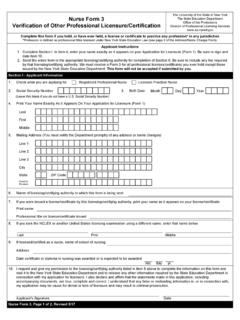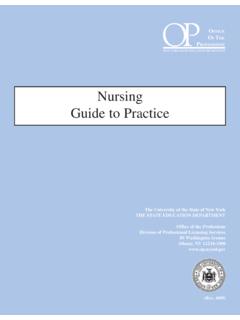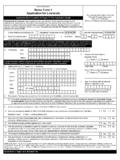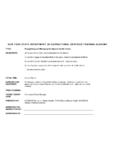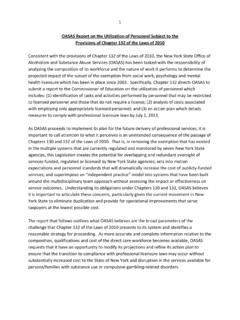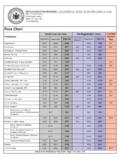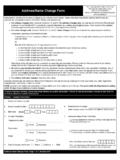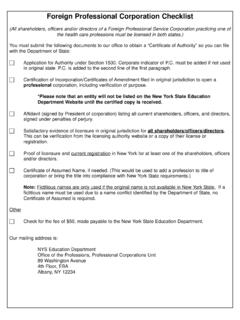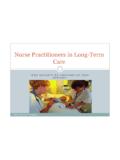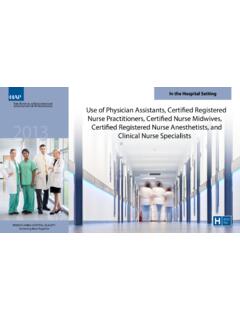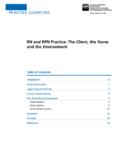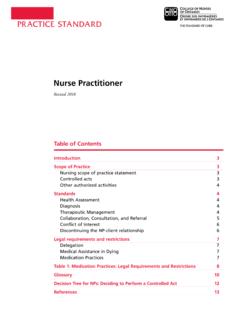Transcription of Practice Requirements for Nurse Practitioners
1 Practice Requirements for Nurse Practitioners I. Collaborative Practice According to New York State Education Law 6902, a Nurse practitioner (NP) diagnoses illnesses and physical conditions and performs therapeutic and corrective measures within the specialty area of Practice in which the NP is certified. New York certifies NPs to Practice in the following specialty areas: Adult Health; Family Health; Gerontology; Neonatology; Obstetrics; Oncology; Pediatrics, Perinatology; Psychiatry; School Health; Women s Health; Holistic; and Palliative Care. New York State Education Law holds NPs independently responsible for the diagnosis and treatment of their patients and does not require an NP to Practice under physician supervision.
2 As described in more detail below, this law requires each NP to Practice in accordance with written Practice protocols and a written Practice agreement with a collaborating physician. However, starting on January 1, 2015, an NP with more than 3600 hours of qualifying NP Practice experience can opt to: continue to Practice pursuant to a written Practice protocols and a written Practice agreement with a collaborating physician, as described in Section II Practicing in Accordance with a Written Practice Agreement with a Collaborating Physician , below; or, Practice and have collaborative relationships with one or more qualified physicians or New York State Health Department licensed health care facility ( , hospital, nursing home, ambulatory surgery center, or diagnostic and treatment center), as described in Section III, Collaborative Relationships , below.
3 II. Practicing in Accordance with a Written Practice Agreement with a Collaborating Physician New York State Education Law requires all Nurse Practitioners (NPs) to Practice in accordance with written Practice protocols and a written Practice agreement with a collaborating physician, unless the NP practices and has collaborative relationships as allowed by law and as described in more detail in Section III, Collaborative Relationships , below. This section describes the New York State Education Law specific Requirements for practicing in accordance with written Practice protocols and a written Practice agreement with a collaborating physician. This law requires that the NP collaborate with a physician who is qualified to collaborate in the NP s specialty area of Practice .
4 The NP must Practice in accordance with written Practice protocols and a written Practice agreement with the collaborating physician. Written Practice Agreements In order to Practice , a Nurse practitioner (NP) must enter into a written collaborative Practice agreement with a physician qualified to Practice in the NP s specialty area of Practice . Written collaborative Practice agreements include provisions addressing: Patient referral and consultation. Coverage for emergency absences of either the NP or the collaborating physician. Resolution of disagreements between the NP and the collaborating physician regarding diagnosis and treatment. If the agreement doesn t address this, the collaborating physician s diagnosis or treatment shall prevail.
5 Peer review by the collaborating physician of patient records in a timely fashion, but no less often than every 3 months. New York Law does not specify the number of charts that must be reviewed by the collaborating physician. That decision is left to the judgment of the NP and collaborating physician, and may vary depending on such factors as: the NP s experience, the collaborating physician s knowledge of the NP s abilities, the population to be served and the Practice setting. Identification of written Practice protocols that the NP will use. Additional provisions as agreed to by the NP and the collaborating physician. A copy of the collaborative Practice agreement must be kept at the NP s Practice setting(s) and made available for inspection by the New York State Education Department (SED).
6 A copy can be found at You may use that as a model. Many NPs work for 2 or more health care providers or at a facility with patients who are being cared for by several different physicians. The Education Law does not necessarily require that the NP to enter into multiple collaborative agreements in such situations. For example: If an OB-GYN NP works at an obstetrician s Practice 3 days a week and at Planned Parenthood for 2 days a week, the NP could enter into a collaborative Practice agreement with the obstetrician. The collaborative Practice agreement could identify a physician (other than the obstetrician) at Planned Parenthood to review the charts of the NP s Planned Parenthood patients, or, alternatively, the obstetrician could review the NP s charts at Planned Parenthood.
7 The NP is not required to enter into a second collaborative agreement. If an NP works in a nursing home, the medical director may serve as the collaborating physician. In case of a disagreement between the NP and an attending physician, the medical director could mediate the dispute and make the final treatment decision. The NP is not legally required to have written collaborative Practice agreements with all of the attending physicians. Written Practice Protocols Nurse Practitioners (NPs) are required to Practice pursuant to written protocols reflecting the specialty area(s) of Practice in which the NP is certified. The protocols must also reflect current, accepted medical and nursing Practice . Additional protocols in subspecialty areas ( , hematology, orthopedics, dermatology) that are appropriate to the NP s Practice may be used but need not be reflected in the collaborative Practice agreement.
8 A list of many, but not all recommended Practice Protocols can be found at Form 4NP Verification of Collaborative Agreement and Practice Protocol A newly certified Nurse practitioner (NP) is required file with the New York State Education Department (SED) Form 4NP- Verification of Collaborative Agreement and Practice Protocol within 90 days after starting professional Practice . The NP is not required to file any additional Form 4NP with SED. A completed Form 4NP is not equivalent to a collaborative Practice agreement. Copies of Form 4NP can be downloaded from SED s website at Note: The Education Law does not require physicians to supervise the NP or to co-sign the NP s orders or medical records. It does require the collaborating physician to review the NP s patient records at least every three months.
9 III. Collaborative Relationships (Effective January 1, 2015) This section describes a new law, The Nurse Practitioners Modernization Act, which allows certain experienced Nurse Practitioners (NPs) to Practice more autonomously. Starting on January 1, 2015, each NP with more than 3,600 hours of qualifying NP Practice experience can opt to: Practice in accordance with a written Practice agreement with a collaborating physician, as described above in Section II Practicing in Accordance with a Written Practice Agreement with a Collaborating Physician ; or, Practice and have collaborative relationships with a qualified physician or a New York State Health Department licensed health care facility ( , hospital, nursing home, ambulatory surgery center, or diagnostic and treatment center), as described in more detail in this section.
10 The new law defines collaborative relationships as when an NP communicates, by phone, in person in writing or electronically with a physician qualified to collaborate in the specialty involved or in the case of a licensed health care facility, communicates with a physician qualified to collaborate in specialty involved who has privileges at such health care facility for the purpose of exchanging information in order to provide comprehensive care or to make referrals, as necessary. The NP may Practice and have collaborative relationships, provided that the following criteria below are met: The NP must have more than 3,600 hours of experience practicing as a licensed or certified NP pursuant to the laws of New York or another state or practicing as an NP while employed by the United States veteran s administration, the United States armed forces or the Unites States public health service.
